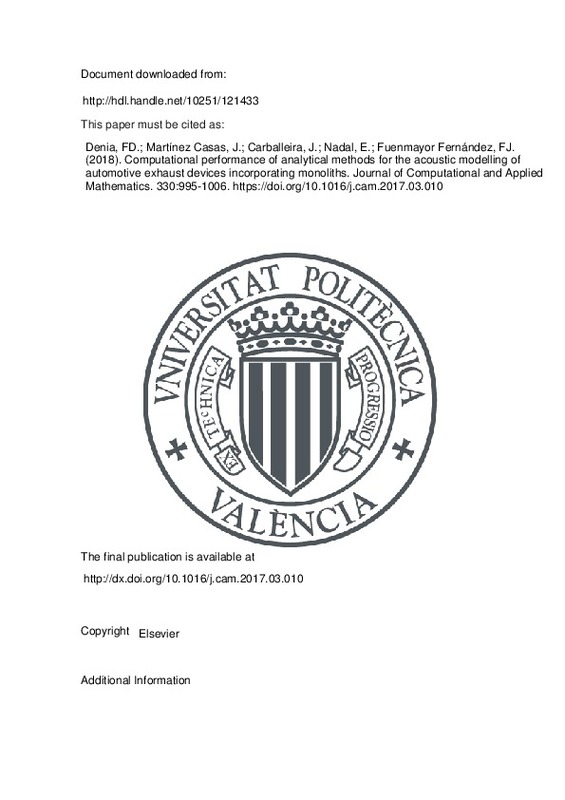JavaScript is disabled for your browser. Some features of this site may not work without it.
Buscar en RiuNet
Listar
Mi cuenta
Estadísticas
Ayuda RiuNet
Admin. UPV
Computational performance of analytical methods for the acoustic modelling of automotive exhaust devices incorporating monoliths
Mostrar el registro sencillo del ítem
Ficheros en el ítem
| dc.contributor.author | Denia, F. D.
|
es_ES |
| dc.contributor.author | Martínez Casas, José
|
es_ES |
| dc.contributor.author | Carballeira, Javier
|
es_ES |
| dc.contributor.author | Nadal, Enrique
|
es_ES |
| dc.contributor.author | Fuenmayor Fernández, Francisco Javier
|
es_ES |
| dc.date.accessioned | 2019-06-02T20:01:21Z | |
| dc.date.available | 2019-06-02T20:01:21Z | |
| dc.date.issued | 2018 | es_ES |
| dc.identifier.issn | 0377-0427 | es_ES |
| dc.identifier.uri | http://hdl.handle.net/10251/121433 | |
| dc.description.abstract | [EN] The acoustic modelling of automotive exhaust devices, such as catalytic converters (CC) and diesel particulate filters (DPF), usually requires the use of multidimensional analytical and numerical techniques. The presence of higher order modes and three-dimensional waves in the expansion and contraction subdomains, as well as sound propagation within the monolith capillary ducts, can be considered through the finite element method (FEM), although this approach is traditionally thought to be very time consuming. With a view to overcome this limitation and to reduce the computational effort of the FEM, alternative modelling techniques are presented in the current work to speed up transmission loss calculations in exhaust devices incorporating monoliths. These approaches are based on the point collocation technique and the mode matching method. As shown in earlier studies, the sound attenuation of an exhaust device incorporating a monolith can be properly predicted if the latter is replaced by a plane wave four-pole transfer matrix providing a relationship between the acoustic fields at both sides of the monolithic region. Therefore, this work combines the presence of multidimensional higher order modes in the expansion and contraction regions with one-dimensional wave propagation within the capillary ducts of the central monolith. The point collocation technique and the mode matching method are applied to the compatibility conditions of the acoustic fields at all the subdomain interfaces to couple the solutions of the wave equation in the corresponding exhaust device subcomponents. For the particular case of rigid circular ducts, Bessel functions are considered as transversal pressure modes. The computational efficiency and accuracy of the results associated with the two analytical modelling techniques presented here are assessed, including the effect of the number of modes and collocation points, as well as their location. All the analytical approaches proposed in this work provide accurate predictions of the device attenuation performance and outperform the computational expenditure of a FE computation. Some differences are found, however, among the various analytical schemes in terms of computational speed and solution accuracy. From the results presented here, the mode matching method is the most efficient technique for the particular configurations under study, mainly due to the possibility of exploiting the orthogonality properties of the transverse pressure modes. | es_ES |
| dc.description.sponsorship | This work has been supported by Ministerio de Economia y Competitividad and the European Regional Development Fund (project TRA2013-45596-C2-1-R), as well as Generalitat Valenciana (projects Prometeo/2016/007 and GV/2016/011 of Conselleria d'Educacio, Investigacio, Cultura i Esport). | es_ES |
| dc.language | Inglés | es_ES |
| dc.publisher | Elsevier | es_ES |
| dc.relation.ispartof | Journal of Computational and Applied Mathematics | es_ES |
| dc.rights | Reconocimiento - No comercial - Sin obra derivada (by-nc-nd) | es_ES |
| dc.subject | Acoustic Modelling | es_ES |
| dc.subject | Sound Attenuation | es_ES |
| dc.subject | Transmission Loss | es_ES |
| dc.subject | Automotive Exhaust Device | es_ES |
| dc.subject | Monolith | es_ES |
| dc.subject | Catalytic Converter | es_ES |
| dc.subject | Mode Matching Method | es_ES |
| dc.subject | Point Collocation Technique | es_ES |
| dc.subject | Transfer Matrix | es_ES |
| dc.subject | Finite Element Method | es_ES |
| dc.subject | Computational Performance. | es_ES |
| dc.subject.classification | INGENIERIA MECANICA | es_ES |
| dc.title | Computational performance of analytical methods for the acoustic modelling of automotive exhaust devices incorporating monoliths | es_ES |
| dc.type | Artículo | es_ES |
| dc.identifier.doi | 10.1016/j.cam.2017.03.010 | es_ES |
| dc.relation.projectID | info:eu-repo/grantAgreement/GVA//PROMETEO%2F2016%2F007/ES/Modelado numérico avanzado en ingeniería mecánica/ | es_ES |
| dc.relation.projectID | info:eu-repo/grantAgreement/GVA//GV%2F2016%2F011/ | es_ES |
| dc.relation.projectID | info:eu-repo/grantAgreement/MINECO//TRA2013-45596-C2-1-R/ES/DESARROLLO DE NUEVAS TECNOLOGIAS DESTINADAS A REDUCIR EL IMPACTO ACUSTICO DEL TRANSPORTE FERROVIARIO EN ENTORNOS URBANOS/ | es_ES |
| dc.rights.accessRights | Abierto | es_ES |
| dc.contributor.affiliation | Universitat Politècnica de València. Departamento de Ingeniería Mecánica y de Materiales - Departament d'Enginyeria Mecànica i de Materials | es_ES |
| dc.description.bibliographicCitation | Denia, FD.; Martínez Casas, J.; Carballeira, J.; Nadal, E.; Fuenmayor Fernández, FJ. (2018). Computational performance of analytical methods for the acoustic modelling of automotive exhaust devices incorporating monoliths. Journal of Computational and Applied Mathematics. 330:995-1006. https://doi.org/10.1016/j.cam.2017.03.010 | es_ES |
| dc.description.accrualMethod | S | es_ES |
| dc.relation.publisherversion | http://dx.doi.org/10.1016/j.cam.2017.03.010 | es_ES |
| dc.description.upvformatpinicio | 995 | es_ES |
| dc.description.upvformatpfin | 1006 | es_ES |
| dc.type.version | info:eu-repo/semantics/publishedVersion | es_ES |
| dc.description.volume | 330 | es_ES |
| dc.relation.pasarela | S\329164 | es_ES |
| dc.contributor.funder | Generalitat Valenciana | es_ES |
| dc.contributor.funder | Ministerio de Economía, Industria y Competitividad | es_ES |







![[Cerrado]](/themes/UPV/images/candado.png)

